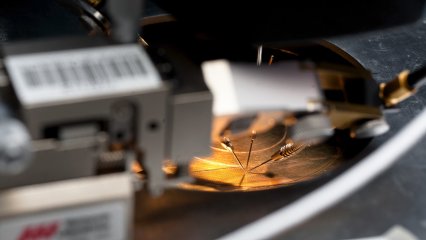
Printed and flexible electronics
The main drive for our activities is to bridge a gap between the nano-world and real life applications. In particular, solution processable semiconducting nano-blocks, including inorganic nanowires, conjugated polymers and carbon nanotubes can be deposited by wet-coating methods and various self-assembly techniques to result in large area electronics.
Overview
Solution-based fabrication of electronic and opto-electronic devices using functional ‘inks’ at low temperatures and on large area substrates is an attractive printed electronics technology for the development of low-cost, lightweight and flexible electronics, including:
- Circuits
- Displays
- Energy harvesting and storage devices
- Lasers
- Memory elements
- Reconfigurable antennas
- Sensors.
We utilise a variety of printing techniques for materials deposition including ink-jet printing, screen printing, slot-die coating, wire bar coater to produce the most important electronics ‘building blocks’ such as field-effect transistors, diodes, photovoltaic cells, photoconducting elements, photodiodes and sensors. Fabrication of conducting tracks is essential for all types of devices.
The ability to produce customisable, digitally printable, antennas and reflectors for RF applications with integrated printable switching elements has opened vast opportunities for low-cost fabrication of microwave devices.
What we print
- Dielectrics (polymers, spin-on-glass).
Semiconducting materials
- Organic semiconductors (polymers and small molecules)
- Nanomaterials (semiconducting nanowires, CNTs).
Conductors
- Metal nanoparticles
- Conducting polymers (PEDOT:PSS)
- Composites (PEDOT:PSS and carbon nanotubes).
Projects
- EPSRC “From nanowires to printed electronics”, (EP/I017569/1)
- EU: “HOMES”, Indoor communication terminal with flexible Substrate, European programme INTERREG IVA 2007-2013 France (Channel) – England, Ref. 5700/4289 & FEDER Upper-Normandy Region
- Industry funded: “Nanowire field-effect transistors for sensor applications”
- NPL funded: “Advanced characterisation of semiconducting materials for electronic devices.”
Academic and industrial collaborations
- National Physical Laboratory, Teddington, UK
- The University of Texas, Austin, Department of Chemical Engineering, USA
- National Institute of Standards and Technology, Boulder (Colorado) and Gaithersburg (Maryland), USA
- Australian National University, Department of Electronic Materials Engineering, Canberra, Australia
- More than 10 UK based companies
- University of Kent, School of Engineering and Digital Arts, Kent , UK
- ESIGELEC/IRSEEM, Rouen, France.
